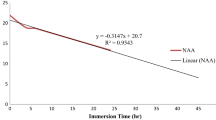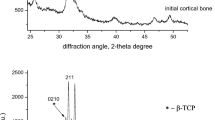Abstract
Calcium and phosphorus concentrations as well as the Ca/P ratio were estimated in intact rib bone samples from healthy humans, 37 women and 45 men, aged 15–55 yr. For Ca and P concentration measurements, instrumental neutron activation analysis was used. The mean values (mean±SD) for the investigated parameters were 19.3±4.5% of dry bone weight, 8.42±2.14% of dry bone weight, and a ratio of 2.33±0.34, respectively. Statistically significant differences for the above parameters were not observed to be related either to age or sex. The mean values for Ca, P, and the Ca/P ratio were within a very wide range of published data and close to their medians. The individual variation for the Ca/P ratio in rib bone from healthy humans was lower than those for Ca and P taken separately. An indication is that the specificity of the Ca/P ratio improves upon that for Ca and P concentrations and may be more reliable in the diagnosis of bone disorders.
Similar content being viewed by others
References
G. E. Lewinnek, J. Kelsey, A. A. White, et al., The significance and a comparative analysis of the epidemiology of hip fractures, Clin. Orthop. 152, 35–43 (1980).
H. H. Bolotin and H. Sievanen, Inaccuracies inherent in dual-energy X-ray absorptiometry in vivo bone mineral density can seriously mislead diagnostic/prognostic interpretations of patient-specific bone fragility, J. Bone Miner. Res. 16, 799–805 (2001).
G. Fountos, E. Kounadi, M. Tzaphlidou, et al., The effect of inflammation-mediated osteoporosis (IMO) on the skeletal Ca/P ratio and on the structure of rabbit bone and skin collagen, Appl. Radiat. Isot. 49, 657–679 (1998).
G. Fountos, E. Kounadi, M. Tzaphlidou, et al., In vivo measurement of radius calcium/phosphorus ratio by X-ray absorptiometry, Appl. Radiat. Isot. 51, 273–278 (1999).
G. Fountos, S., Yasumura, and D. Glaros, The skeletal calcium/phosphorus ratio; a new in vivo method of determination, Med. Phys. 24, 1303–1310 (1997).
E. D. Pellegrino and R. M. Biltz, The composition of human bone in uremia, Medicine 44, 397–418 (1965).
V. Zaichick, Sampling, sample storage and preparation of biomaterials for INAA in clinical medicine, occupational and environmental health, in Harmonization of Health-Related Environmental Measurements Using Nuclear and Isotopic Techniques, IAEA, Vienna, pp. 123–133 (1997).
V. Zaichick and S. Zaichick, INAA application for the assessment of chemical element losses under dry ashing of biological materials, in International Conference on Nuclear Analytical Methods in the Life Sciences, pp. 95–97 (1998).
L. M. Mosulishvili, M. A. Kolomi’tsev, V. Yu. Dundua, et al., Multielement standards for instrumental neutron activation analysis of biological materials, J. Radioanal. Chem. 26, 175–188 (1975).
R. Parr, Inter-comparison of minor and trace elements, in IAEA Animal Bone (H-5), Progress Report No. 1, IAEA, Vienna (1982).
V. M. Kalashnikov, V. Ye. Zaichick, and V. V. Proshin, Neutron activation analysis of bone minerals, Med. Radiol. 7, 82–86 (1975).
A. M. Korelo and V. Ye. Zaichick, Software to optimize the multielement INAA of medical and environmental samples, in Activation Analysis in Environment Protection, Joint Institute of Nuclear Research, Dubna, Russia pp. 326–332 (1993).
H. G. Woodard, The elementary composition of human cortical bone, Health Phys. 8, 513–517 (1962).
H. S. Vuorinen, S. Pihlman, H. Mussalo-Rauhamaa, et al., Trace and heavy metal analyses of a skeletal population representing the town people in Turku (ABO), Finland in the 16th–17th centuries: with special reference to gender, age and social background, Sci. Total Environ. 177, 145–160 (1996).
J. D. Robertson and D. L. Samudralwar, Ion beam analysis of the bone tissue of Alzheimer’s disease patients, Nucl. Instr. Methods Phys. Res. B64, 553–557 (1992).
D. L. Samudralwar and J. D. Robertson, Determination of major and trace elements in bones by simultaneous PIXE/PIGE analysis, J. Radioanal. Nucl. Chem. Articles 169, 259–267 (1993).
Z. Jaworowski, F. Barbalat, C. Blain, et al., Historical changes of trace metals in human bones from France, in Metals in Bone, N. D. Priest, ed., MTP Press, Lancaster, PA, pp. 383–393 (1985).
I. H. Tipton, J. C. Johns, and M. Boyd, The variation with age of elemental concentrations in human tissue, in Proceedings First International Congress of Radiation Protection, Pergamon, Elmsford, NY, p. 759 (1968).
M. Anke, O. Latunde-Dada, W. Arnhold, et al., The influence of age, sex and cadmium exposure on the ash, calcium, phosphorus, trace element and ultra trace element content in skeleton, kidneys and liver of humans, in Advances in the Prevention of Environmental Cadmium Pollution and Countermeasures, Eiko Laboratory, Kanazawa (1999) Germany.
H. J. Schneider and M. Anke, Die Abhangigkeiten des Kalzium-, Phosphor-und Mangangehaltes verschiedener Organe des Menschen. Arch. Expr. Vet. Med. 25, 787–792 (1971).
J. Yoshinaga, T. Suzuki, and M. Morita, Sex- and age-related variation in elemental concentrations of contemporary Japanese ribs, Sci. Total Environ. 79, 209–221 (1989).
J. Yoshinaga, T. Suzuki, M. Morita, et al., Trace elements in ribs of elderly people and elemental variation in the presence of chronic diseases, Sci. Total Environ. 162, 239–252 (1995).
T. Gassman, Chemische Untersuchungen von gesungen und rhachitishen Knochen, Hoppe-Seyler’s Z. Physiol. Chem. 70, 161–170 (1910).
I. S. Edelman, A. H. James, H. Baden, et al., Electrolyte composition of bone and the penetration of radiosodium and deuterium oxide into dog and human bone, J. Clin. Invest. 33, 122–131 (1954).
R. M. Forbes, A. R. Cooper, and H. H. Mitchell, The composition of the adult human body as determined by chemical analysis, J. Biol. Chem. 203, 359–366 (1953).
H. J. Koch and E. R. Smith, The determination of copper and zinc in normal and pathologic human thyroid tissue, J. Clin. Endocrinol. Metab. 16, 123–129 (1956).
J. W. Agna, H. C. Knowles, and G. Alverson, The mineral content of normal human bone, J. Clin. Invest. 37, 1357–1361 (1958).
F. D. Moore, J. Lister, C. M. Boyden, et al., The skeleton as a feature of body composition, Hum. Biol. 40, 135–188 (1968).
M. D. Crawford and T. Crawford, Lead content of bones in a soft and hard water area, Lancet 7597, 699–701 (1969).
A. Forssen, Inorganic elements in the human body. Ann. Med. Exp. Biol. Fenniae 50, 99–162 (1972).
H. A. Schroeder, I. H. Tipton, and A. P. Nason, Trace metals in man: strontium and barium. J. Chron. Dis. 25, 491–517 (1972).
P. Bratter, D. Gawlik, J. Lausch, et al., On the distribution of the trace elements in human skeletons, J. Radioanal. Chem. 37, 393–403 (1977).
O. G. Gasenko, A. A. Prohonchukov, B. B. Panikarovsky, et al., Condition of microscopic and crystal structures, microhardness, and minerals of human bone after long space flight, Kosmicheskaya Biol. Aviakosmicheskaya Med. 11, 11–20 (1977).
Y. Suzuki, The normal levels of fluorine in the bone tissue of Japanese subjects, Tohoku J. Exp. Med. 129, 327–336 (1979).
G. Tanaka, H. Kawamura, and E. Nomura, Distribution of strontium in the skeleton and in the mass of mineralized bone, Health Phys. 40, 601–614 (1981).
M. M. Erickson, A. Poklis, G. E. Gantner, et al., Tissue mineral levels in victims infant death syndrome II. Essential minerals: copper, zinc, calcium, and magnesium, Pediatr. Res. 17, 784–787 (1983).
K. J. Quelch, R. A. Melick, P. J. Bingham, et al., Chemical composition of human bone, Arch. Oral Biol. 28, 665–674 (1983).
J. H. Kyle, Effect of post-burial contamination on the concentrations of major and minor elements in human bones and teeth—the implications for palaeodietary research, J. Archaeol. Sci. 13, 403–416 (1986).
A. Hisanaga, M. Hirata, A. Tanaka, et al., Variation of trace metals in ancient and contemporary Japanese bones, Biol. Trace Element Res. 22, 221–231 (1989).
M. Saiki, M. K. Takata, S. Kramarski, et al., Instrumental neutron activation analysis of rib bone samples and of bone reference materials, Biol. Trace Element Res. 71–72, 41–46 (1999).
S. L. Tompsett, The lead content of human tissue and excreta, Biochem. J. 29, 1851–1853 (1935).
S. L. Tompsett, The distribution of lead in human bones, Biochem. J. 30, 345–349 (1936).
D. A. Henderson and J. A. Inglis, The lead content of bone in chronic Bright’s diseases, Aust. Ann. Med. 6, 145–151 (1957).
N. Yamagata, The concentration of common cesium and rubidium in human body, J. Radiat. Res. 3, 9–30 (1962).
R. E. Nusbaum, E. M. Butt, T. C. Gilmour, et al., Relation of air pollution to trace metals in bone, Arch. Environ. Health 10, 227–232 (1965).
C. D. Strechlow and T. J. Kneip, The distribution of lead and zinc in the human skeleton, Am. Ind. Hyg. Assoc. J. 30, 372–378 (1969).
T., Nozaki, M. Schikawa, T. Sasuga, et al., Neutron activation analysis of uranium in human bone, drinking water and daily diet, J. Radioanal. Chem. 6, 33–40 (1970).
S. B. Gross, E. A. Pfitzer, D. W. Yeager, et al., Lead in human tissues, Toxicol. Appl. Pharmacol. 32, 638–651 (1975).
L. Ulrich, The investigation of lead levels in vertebra and rib samples, Arch. Toxicol. 41, 133–148 (1978).
L. E. Wittmers, J. Wallgren, A. Alich, et al., Lead in bone IV. Distribution of lead in human skeleton, Arch. Environ. Health 43, 381–391 (1988).
B. E. Saltzman, S. B. Gross, D. W. Yeager, et al. Total body burdens and tissue concentrations of lead, cadmium, copper, zinc, and ash in 55 human cadavers, Environ. Res. 52, 126–145 (1990).
Author information
Authors and Affiliations
Rights and permissions
About this article
Cite this article
Tzaphlidou, M., Zaichick, V. Calcium, Phosphorus, calcium-phosphorus ratio in rib bone of healthy humans. Biol Trace Elem Res 93, 63–74 (2003). https://doi.org/10.1385/BTER:93:1-3:63
Received:
Accepted:
Issue Date:
DOI: https://doi.org/10.1385/BTER:93:1-3:63




